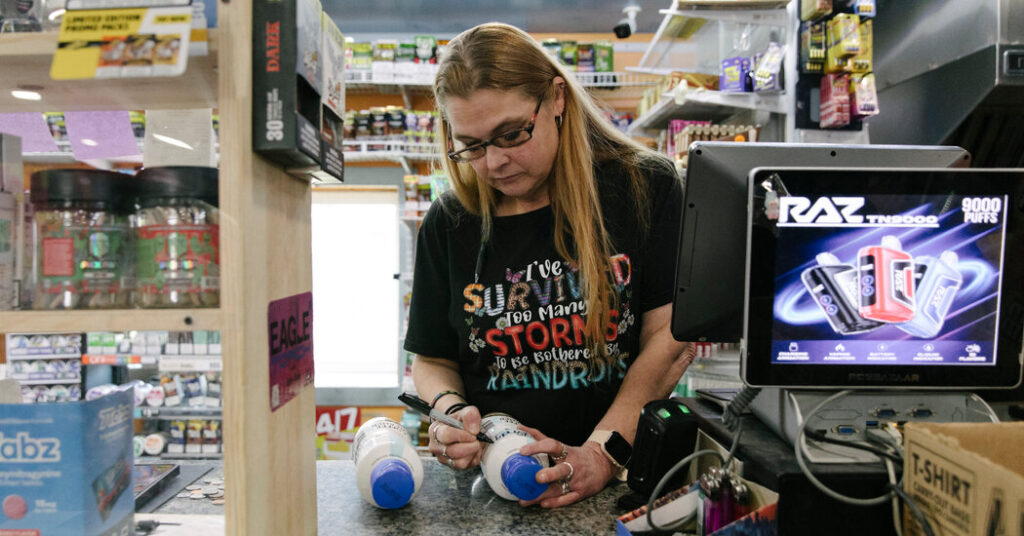More than two hours before the sun rose, Mary Schiely opened the doors of Sloan’s Market over the weekend, like she has almost every morning for the past 15 years.
The week of Thanksgiving has finally brought some measure of normalcy to the tiny neighborhood store in Middletown, Ohio, after a month of disruptions, uncertainty and panic wrought by the pause of government food benefits.
Earlier this month, many of the roughly 42 million Americans who rely on the Supplemental Nutrition Assistance Program were left to scrounge for groceries after funding lapsed during the historic 43-day government shutdown.
While benefits have been restored, SNAP recipients still feel the aftermath. And with new SNAP rules, some of which take effect in December, they are bracing for what might come next in a long, complicated and confusing process.
Ms. Schiely, 49, knows better than most how the suspension of SNAP benefits affected the poorest Americans and frayed what was once a reliable social safety net. As the cost of living rises, a majority of her customers depend on the aid to eat. So does Ms. Schiely.
On her recent predawn walk to work, about a half-mile, Ms. Schiely passed the homes of some of Sloan’s regular customers. She knew what its residents buy: “Mr. Two Red Bulls” lives here, she said, “Mrs. Low Fat Milk” occupies the tidy ranch house, and “Ramen Man” is on the corner.
This week, she has watched as customers, including SNAP recipients, purchase ingredients for their Thanksgiving pies. But she also saw the struggle.
“I actually had a customer, who had not received their SNAP, ask for a credit in tears,” she said on Tuesday. “I made sure they had what they needed. Parent of a special-needs child. She got all the sides and even a cake she needed. I was crying with her as she kept apologizing.”
Stacey Gupta, 56, a Sloan’s regular, is battling a brain tumor and other ailments that keep her from working. Her husband just suffered a stroke, and she desperately needs the $700 in SNAP benefits that feeds her family.
This year, Ms. Gupta’s Thanksgiving menu will be pared down to three items because of the SNAP saga: turkey, macaroni and cheese, and potatoes. On Wednesday, she said that she planned to head to Sloan’s to see if she can find gravy packets for her mashed potatoes. “That’s all we can afford,” she said.
Long considered America’s answer to feeding its hungry, SNAP has new rules limiting benefits and is facing new scrutiny that could eventually mean reduced or eliminated benefits for some participants.
The Trump administration’s broad domestic policy law that passed in July cut SNAP funding by $186 billion over the next decade, in part by imposing stricter eligibility requirements and expanding work, job training and volunteer requirements for some adults. Some SNAP costs will be shifted to states, even as some states have warned they might be forced to make their own cuts to fund the program. Those who fail to meet the work requirements are limited to three months of SNAP assistance over a 36-month period.
And in recent weeks, Agriculture Secretary Brooke Rollins announced that SNAP recipients will be required to reapply for the program as part of the administration’s efforts to root out suspected fraud.
“Secretary Rollins wants to ensure the fraud, waste and incessant abuse of SNAP ends, a U.S.D.A. spokesperson said in a statement, adding, “Using standard recertification processes for households is a part of that work.”
Ms. Rollins said her department has reviewed SNAP data from 29 states and found about 186,000 dead people on the rolls. Another half-million, she said, are receiving double benefits. The agency plans to rebuild the program to ensure those receiving taxpayer-funded SNAP benefits “are vulnerable and can’t survive without it,” she said in a Newsmax interview.
Those changes are adding another layer of anxiety.
“I cry all the time, I can’t get a break,” said Erica Brown, 37, who worries that her SNAP benefits will be cut off again because of the new requirements. Ms. Brown said she cannot work because she is taking care of her mom, who has terminal cancer. Without the almost $1,000 she receives each month from SNAP, Ms. Brown was forced to visit food pantries to feed herself and her three children when the benefits were paused.
Advocates said that many of the country’s poorest are caught in a tightening affordability vise. “For many people, the delay in getting benefits in November was absolutely a crisis,” said Crystal FitzSimons, president of the Food Research and Action Center, an anti-poverty advocacy group that supports SNAP. “Families will continue to struggle across the country. They are feeling squeezed in every direction.”
Like other places across the country, the SNAP crisis this month hit Middletown — where Vice President JD Vance was raised — hard. And few places in this small mill city of about 51,000 felt the pinch of hunger more than the neighborhood surrounding Sloan’s. Butler County, where Middletown primarily lies, has just over 40,000 SNAP recipients, according to state data.
The customers who shop at Sloan’s thread a needle between expense and convenience. The store offers a modest and slightly higher priced selection of basic groceries. For those who do not own a car, it is often the best option.
There are other larger stores in the more affluent east side of the city, about four miles away, which means those without a car need to use delivery services or find a ride to get there. For more options, including generic brands, those stores are what Ms. Schiely relies on.
Ms. Schiely works full time for $12 an hour. On many weeks, that means 44 hours at the store. Her largest bill is her $525 rent, which takes two paychecks to cover.
Every month, Ms. Schiely and Alyssa Crutchfield, her 18-year-old daughter, precisely plan how to spend their $500 monthly SNAP allotment.
The mother and daughter, who live in a small two-bedroom duplex, spent an hour one recent afternoon meticulously poring over the price of each item on their list for Walmart. A favorite soy sauce is $3.99, but the store brand is $1.58. They go with the store brand.
By the time they finished, the total was about $130, enough to last about a week. The exercise was a nagging reminder that they are dependent on a federal government that allowed SNAP funding to lapse for the first time.
“The cutting of SNAP taught me to never take the benefits for granted,” said her daughter, a high school senior.
On Thursday, Ms. Schiely had planned to work, but she and her daughter scored a last-minute invite from a friend in Columbus, Ohio, about 90 minutes away by car.
They are going. A day of Thanksgiving and plenty awaits.
Audra D. S. Burch is a national reporter, based in South Florida and Atlanta, writing about race and identity around the country.
The post SNAP Recipients Plan Thanksgiving, Down to Their Last Cent appeared first on New York Times.




